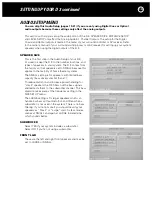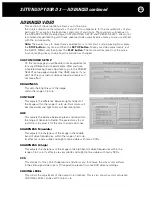
20
CENTER SPEAKER
This may be set to LARGE, SMALL or NONE. Set to
LARGE or SMALL, according to the guidelines in the
previous paragraphs. Set to NONE if your home theater
has no center channel speaker. The D 3 will blend the
center channel signals into your front left and right front
speakers. This creates a “Phantom” center channel
sound image because the center channel sound will
appear to come from the middle space between your
left and right front speakers, even without an actual
center channel speaker.
SURROUND L&R
These are the speakers that are placed at the sides
of your room. This may be set to LARGE, SMALL or
NONE. Set to LARGE or SMALL, according to the
guidelines above. If you select NONE the surround
channel signals are blended into the front channels.
CROSSOVER
This sets the subwoofer bass filter’s cutoff frequency
from 70 Hz to120 Hz, in 10 Hz increments and from
120 Hz to 160 Hz, in 20 Hz increments. The optimum
setting will depend on your speakers, your sub, and
your room’s acoustics. The best starting point is 80 Hz.
Don’t use both the crossover filter in your sub and the
Crossover filter in the D 3, or some bass frequencies
you want may not be heard at all. If your subwoofer
doesn’t have a bypass switch for its crossover filter,
adjust it to its highest frequency setting to minimize
redundant filtering. If your sub has a fixed filter and no
bypass, set the D 3 Sub filter to 160 Hz.
DISTANCE SETUP
Use the DISTANCE SETUP menu to calibrate the arrival
time for the sound from each speaker. Convincing
surround sound depends on the sound reaching your
ears from each speaker at the same time as the recording
engineer intended. For example, if your front speakers
are three feet further from you than your surrounds are,
the sound from the front speakers will reach you about
3 milliseconds (0.003 sec.) later than the surrounds and
you might hear, say, an echo before the shot itself. To
compensate for your speaker placement, your D 3 can
delay the sound from the surround speakers by three
milliseconds, restoring the correct timing. You can set
delays by measuring the distance from each speaker
to your head when you’re seated in your favorite
viewing/listening position and entering it in the
DISTANCE SETUP.
SETTING UP YOUR D 3 continued
Use a measuring tape and note the distance from your primary listening position to each speaker.
The D 3 will translate each foot (.34 meters) of distance for a given channel into 1ms (millisecond)
of delay. For each speaker, the distance can be set in 1-foot increments from 5 to 30 feet (or 1.5 to
9 meters, if you set the UNITS for METERS).
Note:
You cannot set distance for any speakers set to NONE or NO in the SPEAKER SIZE setup page.
Содержание Halo D 3
Страница 1: ......
Страница 32: ...32 LANGUAGE CODE CHART...
Страница 34: ...34 CONNECTION AND SETUP NOTES Notes...
Страница 35: ...35 CONNECTION AND SETUP NOTES Notes...
Страница 36: ......
















































